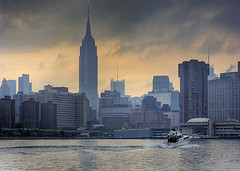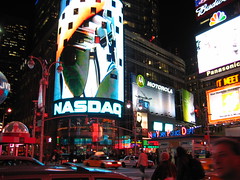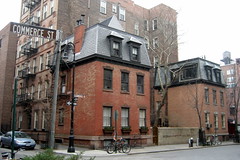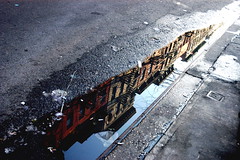New York Songlines
Virtual Walking Tours of Manhattan Streets
Why Songlines?The Aboriginal Australians are able to navigate across their harsh and unforgiving land by memorizing and following
the Songlines—an intricate series of song cycles that identify the landmarks that one needs to pass to get where one
needed to go.
Far from aboriginal, most New Yorkers weren't even born here, and this overpopulated isle may seem like the opposite of
Australia's trackless deserts.
After a slight period of disorientation, we generally find our way around all right, whether
we rely on street signs, subway maps or the taxi driver's orienteering skills. North of 14th Street and west of 6th Avenue,
at least, the streets mainly run in straight lines and meet at right angles, and you can usually get where you're going just
by following your feet.
But by relying on maps, signs and Manhattan's perpendicular geography, New Yorkers have given up something important: a
sense of place.
Which is a shame, because New York has its own giants, heroes and monsters who left their marks and their names on the
land around us.
To this end I offer these as the New York Songlines. An
oral culture uses
song as the most efficient way to remember and transmit large
amounts of information; the Web is our technological
society's closest equivalent.
Don't feel you need to travel in a straight line, however;
at most intersections you can click on one of the arrows
to turn the corner and explore a new Songline.
New York City is constantly changing; don't be
"I believe that anybody living anywhere upon the face of the globe, if they were to simply take the time and do the research, would find an incredible nest of wonders buried right where they were standing, right in their own backyard. I think that all too often, in the 21st Century, and throughout the 20th Century, we tend to spend our everyday existence walking along streets or driving along streets that we have no real understanding of, even if we see them everyday, and they just become fairly meaningless and bleak blocks of concrete, whereas, if you happen to know that such-and-such a poet was incarcerated inside an asylum upon this street or that such-and-such a murder happened here or that such-and-such a fabulous, legendary queen is buried in this vicinity: all of these little stories, it makes the places that we live much richer if we have a knowledge of these things. All of a sudden, you're not walking down mundane, dull, everyday streets anymore, you're walking down fabulous avenues full of wonderful ideas and incredible stories."
"No matter how long you have been here, you are a New Yorker the first time you say, That used to be Munsey's, or That used to be the Tic Toc Lounge.... You are a New Yorker when what was there before is more real and solid than what is here now."
|
Places to Start:
Times Square:Broadway and 42nd Street New York Public Library:Grand Central Terminal:Empire State Building:Macy's:Broadway and 34th Street Madison Square Garden:Madison Square Park:Madison and 26th Street The Chelsea Hotel:Ladies' Mile:The Flatiron Building:Broadway and 5th Avenue and 23rd Street Union Square:14th Street and University Place Washington Square Arch:5th Avenue and Washington Square North Cafe Reggio:Jefferson Market Library:Stonewall:Chumley'sSt Marks Church:Cooper Union:3rd Avenue and 8th Street Tompkins Square Park:Avenue A and 10th Street CBGB's:Little Italy:Chinatown:New York Stock Exchange: |
The Songlines:
* I've been adding photos to some of the Songlines via the Flickr photo sharing service.
New Yorkers and others have traveled the Songlines at least times.





